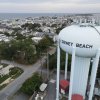Delaware author explores weather at Gettysburg battle
It was a 10-minute rest break that could have changed American history.
Confederate soldiers had just completed a more than 20-mile march to Pennsylvania on the second day of the Battle of Gettysburg, July 2, 1863.
The heat index was 90, and the soldiers were fighting heatstroke in their heavy uniforms made partly of wool.
“They were exhausted. Their canteens were empty. But now, they had to make an assault and they had nothing left in the tank to fight,” said Jeffrey Harding, co-author of “The Weather Gods Curse the Gettysburg Campaign.”
Harding said that 10-minute pause by the Confederates to try and regain some strength allowed Union troops, who had water, to rush into position and repel the rebel attack.
It is one of many stories Harding recounts about the impact that extreme heat and heavy rain had on the Civil War’s bloodiest battle, which saw more than 50,000 casualties over the three-day campaign.
Harding co-authored “The Weather Gods Curse the Gettysburg Campaign” with Dr. Jon Nese, a renowned meteorology professor at Penn State and former presenter on The Weather Channel.
Harding is a historian and licensed battlefield guide. Nese is a scientist who interpreted the weather data.
“Everybody says everything that can be written about Gettysburg has been written; this is an exception. We never had a full accounting of the weather,” Harding said.
Harding is a Maryland native who now lives in Long Neck.
He grew up a student of history thanks to his mother, who was a teacher.
During his career as an intelligence analyst for the Navy, he became a leading historian of World War II Adm. Chester Nimitz.
Harding still conducts tours of the Gettysburg Battlefield and teaches a leadership course.
In 2017, he began his deep dive into what the weather was before, during and after the three-day battle, which proved to be the turning point of the war.
Harding sought to find the original records kept by a professor named Michael Jacobs at then-Pennsylvania College in Gettysburg. Jacobs was part of the Smithsonian Institution’s growing network of weather observers.
“Jacobs took basic measurements — temperature, barometric pressure and wind calculations — three times a day. But, Nese discovered that he did not observe the wet bulb temperature,” Harding said.
Harding said the wet bulb temperature readings would have measured the dew point, but there was no heat index back then to identify a “feels like” temperature.
“The link between dew point and human comfort was somewhat understood in 1863 by scientists who cared about such things, but nobody, to my knowledge, talked about it much in their writing for the purpose of describing human comfort,” according to Nese.
Harding and Nese found that two observers in Harrisburg did use wet bulb temperature readings so, for the first time, some critical weather details were uncovered.
Harding said the temperature at the start of Pickett’s Charge on July 3 was 87 degrees, but the heat index was 105. He said another calculation found that the ground temperature was 136.
Harding said the uniforms worn by soldiers of both the North and the South were not designed to handle the heat.
“The Union’s were wool. The Southerners were wearing jean cloth, which is a combination of wool and cotton, so they were a little better off in the summer, but they’re all wearing drawers, which were flannel for Union troops, cotton for Southerners,” he said.
The weather also played a role in the days following the battle.
Harding said when Lee’s Army of Northern Virginia retreated from Gettysburg on July 4, 1863, they were supposed to cross the Potomac River in two places, Williamsport, Md., and Falling Waters, Md.
However, when they got to the river, it was swollen from heavy rain. A pontoon bridge they had counted on for the crossing had been partially destroyed by Union troops, then washed away.
“Fording level was 2-3 feet. But the river had swollen to 15-20 feet. They were trapped. It would have taken 3-4 inches of rain to cause it to get that high,” Harding said. “Nese found very few instances of the river ever getting that high in July.”
Lee’s troops had to wait about a week for the river to subside before they could escape.
The extreme weather also made it difficult for the 21,000 wounded who were left behind in Gettysburg.
“They were outdoors or in homes, of course without air conditioning. Heat indexes of over 100 added to the suffering and the risk of infection. It was worse for those indoors than outdoors, because at least a breeze could help,” Harding said.
Harding said less-extreme weather would not have changed the outcome of the Gettysburg battle.
“If Lee’s artillery had prevailed against the Union artillery, if supporting troops had been in position where he needed them, if Union troops had not fought as staunchly, he had a chance. If all those chances come into play and your men weren’t as physically exhausted from the heat, then maybe you’d have something different. But the weather alone wouldn’t have been a factor,” Harding said.
Harding said the weather research done during the Civil War played a role in the creation of the National Weather Service in 1870 by President Ulysses S. Grant.
“He goes back to the research that was done from the Smithsonian and the people who have done it,” Harding said. “One of the first curriculums is provided by a professor from then-Pennsylvania College, professor Michael Jacobs. So, it kind of comes full circle.”
As far as the book title, he said it just came to them.
“When we looked at the fact that the weather was worse during the battle then we had ever known, and then we looked at the unprecedented situation on the Potomac, and we said, ‘The weather gods, they had it in for both sides,’” Harding said.

Bill Shull has been covering Lewes for the Cape Gazette since 2023. He comes to the world of print journalism after 40 years in TV news. Bill has worked in his hometown of Philadelphia, as well as Atlanta and Washington, D.C. He came to Lewes in 2014 to help launch WRDE-TV. Bill served as WRDE’s news director for more than eight years, working in Lewes and Milton. He is a 1986 graduate of Penn State University. Bill is an avid aviation and wildlife photographer, and a big Penn State football, Eagles, Phillies and PGA Tour golf fan. Bill, his wife Jill and their rescue cat, Lucky, live in Rehoboth Beach.





















































